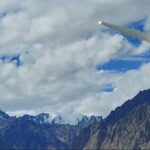Prime Minister Narendra Modi marked India’s 79th Independence Day on Friday with his longest-ever address from the Red Fort, delivering a 103-minute roadmap to a “Viksit Bharat” by 2047 that blended economic reform, technological ambition, and an unapologetic national security doctrine.
The speech – delivered days after Operation Sindoor dismantled Pakistan-based terror infrastructure in retaliation for the Pahalgam attack – used the language of self-reliance as both an economic imperative and a strategic weapon.
Operation Sindoor: Proof of Strategic Autonomy
Modi opened with a forceful endorsement of Operation Sindoor as a “demonstration of India’s strategic autonomy,” highlighting that it was executed entirely with domestically built weapons and surveillance systems.
“No blackmail, no compromise,” he said, in an apparent reference to Pakistan’s nuclear posturing. Linking the operation to his broader vision, Modi declared that India will not tolerate arrangements – such as the Indus Waters Treaty – that, in his words, “irrigated enemy lands while our farmers suffered.”
Defense Self-Reliance: Jet Engines to Mission Sudarshan Chakra
The centerpiece of Modi’s defense announcements was a national challenge to build indigenous jet engines – a long-standing vulnerability in India’s military supply chain. “Just as we made our own vaccines during COVID and UPI for digital payments, we must now make our own jet engines,” he told the nation, framing the project as a matter of sovereignty.
The Prime Minister also unveiled Mission Sudarshan Chakra, aimed at developing rapid-response, precision weapon systems, and pledged that “all public places will be covered by a nationwide security shield by 2035.”
Industrial and Technological Leap
Modi’s economic self-reliance agenda included:
- First Made-in-India semiconductor chip to roll out by 2025.
- Opening the nuclear sector to private players.
- National Critical Minerals Mission to explore 1,200 sites for minerals essential to energy, defense, and manufacturing.
- National Deepwater Exploration Mission to harness offshore energy resources and cut fuel import dependence.
“Dependence on others raises questions about a nation’s independence,” Modi said, warning against allowing import reliance to become “a dangerous habit.”
Health and Pharma Sovereignty
Recasting India’s role as the “pharmacy of the world,” Modi called for self-reliance in developing new medicines, vaccines, and treatments. Drawing on the COVID-19 vaccine experience, he urged researchers to secure patents and expand indigenous innovation to meet both domestic needs and global health demands.
Economic Reform and Youth Employment
Modi announced the formation of a Task Force for Next-Generation Economic Reforms, citing the removal of over 40,000 compliance requirements and 1,500 outdated laws since 2014.
He promised Next-Generation GST reforms by Diwali to cut taxes on essentials and help MSMEs and consumers. The new PM Viksit Bharat Rozgar Yojana, worth ₹1 lakh crore (about $12 billion), will provide ₹15,000 (around $180) to newly employed youth, targeting 3 crore (30 million) beneficiaries.
Energy and Nuclear Expansion
India has reached its 50% clean energy target five years ahead of schedule, Modi said, and plans to increase nuclear power capacity tenfold by 2047 with 10 new reactors underway. Savings from reduced energy imports, he noted, could be redirected to farmer welfare.
Space and Strategic Technology
Building on the Gaganyaan mission, Modi confirmed preparations for an Indian space station and noted over 300 domestic startups in the space sector, reflecting his goal for India to be a technology leader, not a follower.
Agriculture and Farmers’ Protection
Reiterating his pledge to stand as a “wall” for farmers, Modi cited India’s global rankings in milk, pulses, rice, and wheat, and announced the PM Dhanya Dhanya Krishi Yojana for 100 backward farming districts. Agricultural exports, he said, have crossed ₹4 lakh crore (around $48 billion), underlining the sector’s competitiveness.
Demographic Security
Warning against illegal infiltration and demographic imbalance in border regions, Modi launched the High-Powered Demography Mission to safeguard national unity and integrity.
Message to Adversaries and Allies
Analysts note the speech carried a dual signal: to adversaries, that India’s strike capabilities and strategic levers – from water to weaponry – will increasingly be immune to foreign pressure; to partners, that India’s market will open in select sectors, but core security technology will be domestically built.
“Operation Sindoor showed what India can do today. By 2047, it must be able to do all of it – and more – without asking anyone’s permission,” Modi concluded.






